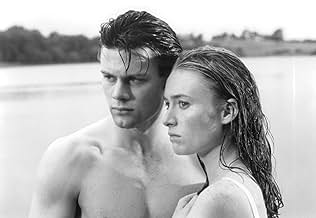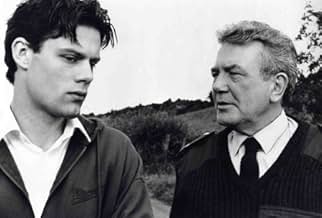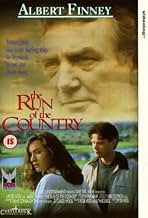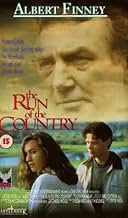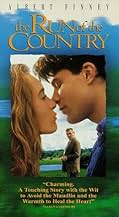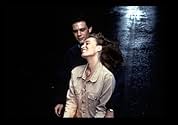NOTE IMDb
6,2/10
488
MA NOTE
Dans un petit village situé à la frontière de l'Irlande, la relation entre un policier au caractère bien trempé et son fils rebelle devient encore plus difficile lorsque le jeune homme s'épr... Tout lireDans un petit village situé à la frontière de l'Irlande, la relation entre un policier au caractère bien trempé et son fils rebelle devient encore plus difficile lorsque le jeune homme s'éprend d'une "mauvaise" fille.Dans un petit village situé à la frontière de l'Irlande, la relation entre un policier au caractère bien trempé et son fils rebelle devient encore plus difficile lorsque le jeune homme s'éprend d'une "mauvaise" fille.
- Réalisation
- Scénario
- Casting principal
Avis à la une
This movie is an example of a movie destroying a beautiful story in an attempt to market it to please everyone. TROTC, the book, was a gorgeous 'boys story' about Danny, journeying from boy to man. The film revolves around his relationships with his best friend, Prunty, and his father. While the father remains intact in the film, Prunty is transformed from a heroic, sexual, powerfully built, deceptively savvy man to a neutered town idiot.
In the novel, the women were in the periphery: Danny's mother is dead in the beginning. His love interest is a bland but beautiful girl from the good side of the tracks. Danny is an awkward, gangley teen with bad skin who has no chance with the beautiful girl, but gets her anyway due to his heart and personality.
The movie switches the roles. Danny, still a great personality but now he looks like a Calvin Klein model. The girl, still a bland personality, but now she is equally bland looking. But she gets Danny. Why? The movie gives no clue.
My guess: the story was changed because the film is now aimed at teenage girls who want to see a plain girl with no personality get the super-hunk. Prunty was neutered so he didn't threaten the girls chances. Why switch the action from the 1950s to 1990s? I guess the target audience couldn't have coped with working their brains.
In the novel, the women were in the periphery: Danny's mother is dead in the beginning. His love interest is a bland but beautiful girl from the good side of the tracks. Danny is an awkward, gangley teen with bad skin who has no chance with the beautiful girl, but gets her anyway due to his heart and personality.
The movie switches the roles. Danny, still a great personality but now he looks like a Calvin Klein model. The girl, still a bland personality, but now she is equally bland looking. But she gets Danny. Why? The movie gives no clue.
My guess: the story was changed because the film is now aimed at teenage girls who want to see a plain girl with no personality get the super-hunk. Prunty was neutered so he didn't threaten the girls chances. Why switch the action from the 1950s to 1990s? I guess the target audience couldn't have coped with working their brains.
Charming, almost innocently told tale. Lovely Irish scenery and gentle, calmly-paced acting. Finney's strong presence does not detract, but rather melds into the story well. I found Keesler just right for the "wide-eyed" role he plays as hero of this yarn. The other supporting players also add much flavor to the rustic backdrop.
And the movie has some mild controversy. None of which has to do with cock-fighting or the IRA. It lies within the fiber of the telling. Some have said: formulaic. Some have said: episodic. Some have said: plotless.
Well, then...which is it?
Strictly speaking, "formulaic" movies should have a plot, and plotless movies cannot be "formulaic". Formulaic cannot be "episodic"...
I say: the movie goes about just as life does - haphazardly, full of turns expected and not. Each random event, another one of life's lessons which add to one's strength or weakness.
I recommend this movie to those whose view of life is not an exercise in the breaking the speed of light - but instead of a "taking in" of that light and welcoming the ensuing darkness as a natural flow and balance of all things.
And the movie has some mild controversy. None of which has to do with cock-fighting or the IRA. It lies within the fiber of the telling. Some have said: formulaic. Some have said: episodic. Some have said: plotless.
Well, then...which is it?
Strictly speaking, "formulaic" movies should have a plot, and plotless movies cannot be "formulaic". Formulaic cannot be "episodic"...
I say: the movie goes about just as life does - haphazardly, full of turns expected and not. Each random event, another one of life's lessons which add to one's strength or weakness.
I recommend this movie to those whose view of life is not an exercise in the breaking the speed of light - but instead of a "taking in" of that light and welcoming the ensuing darkness as a natural flow and balance of all things.
This was a disappointment. There's no point in repeating the comments others have made about the dodgy acting. As an Irish person, I can also add that the accents were highly questionable and in some cases just plain wrong. Rites of passage films tend to be pretty formulaic and this one broke no moulds. Nor did it ever intend to.
Near the border of Northern Ireland, an 18 year-old named Danny (Matt Keeslar) leaves home after the death of his mother due to friction with his gruff father, a local cop, (Albert Finney). Danny moves in with his free-spirited friend, Cocoa (Anthony Brophy), and learns the ropes of manhood, including a relationship with a girl from across the border, Annagh (Victoria Smurfit). When crises strike he finally comes to understand some things.
Peter Yates' "The Run of the Country" (1995) is an obscure picture only available on VHS, which isn't relevant in the modern days of streaming. Yet gazillions of people have seen the poster for the movie at a cinema in the 1995 episode of Seinfeld "The Pool Guy" (season 7, episode 8).
This is a realistic coming-of-age drama set in inland Ireland. The acting is effective across the board, especially Finney as the father and Brophy as Danny's wild friend. Simply put, this is quality drama with laughs, romance, conflict, action, crises and gorgeous photography of rural Ireland.
The film runs 1 hour, 49 minutes, and was shot in the Redhills, County Cavan, area of Ireland, near the border of Northern Ireland.
GRADE: B
Peter Yates' "The Run of the Country" (1995) is an obscure picture only available on VHS, which isn't relevant in the modern days of streaming. Yet gazillions of people have seen the poster for the movie at a cinema in the 1995 episode of Seinfeld "The Pool Guy" (season 7, episode 8).
This is a realistic coming-of-age drama set in inland Ireland. The acting is effective across the board, especially Finney as the father and Brophy as Danny's wild friend. Simply put, this is quality drama with laughs, romance, conflict, action, crises and gorgeous photography of rural Ireland.
The film runs 1 hour, 49 minutes, and was shot in the Redhills, County Cavan, area of Ireland, near the border of Northern Ireland.
GRADE: B
The previews looked interesting, and given a penchant for things Irish, I fully expected to enjoy this movie. I was sorely disappointed. The plot, or what there is of a plot, is convoluted and episodic. I'm not one to generally notice what others call bad acting, but the lead definitely could have used some work. All in all, I would say you're better off spending your time some other way.
Le saviez-vous
- AnecdotesFinal theatrically released feature film of British director Peter Yates.
- Bandes originalesPied Piper
Music & Lyrics by Leo Moran & Dave Carton
Performed by The Saw Doctors
Courtesy of Shamtown Records
Meilleurs choix
Connectez-vous pour évaluer et suivre la liste de favoris afin de recevoir des recommandations personnalisées
- How long is The Run of the Country?Alimenté par Alexa
Détails
Box-office
- Montant brut aux États-Unis et au Canada
- 470 768 $US
Contribuer à cette page
Suggérer une modification ou ajouter du contenu manquant


